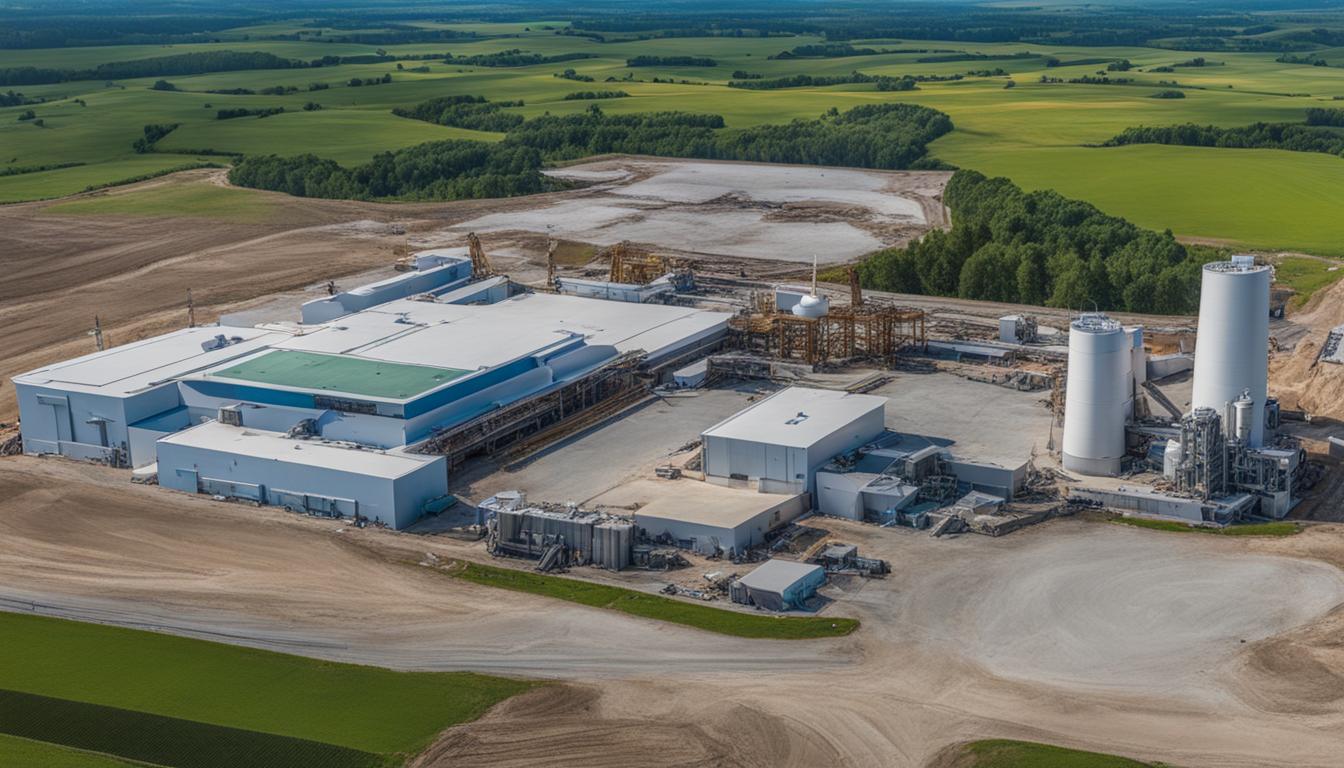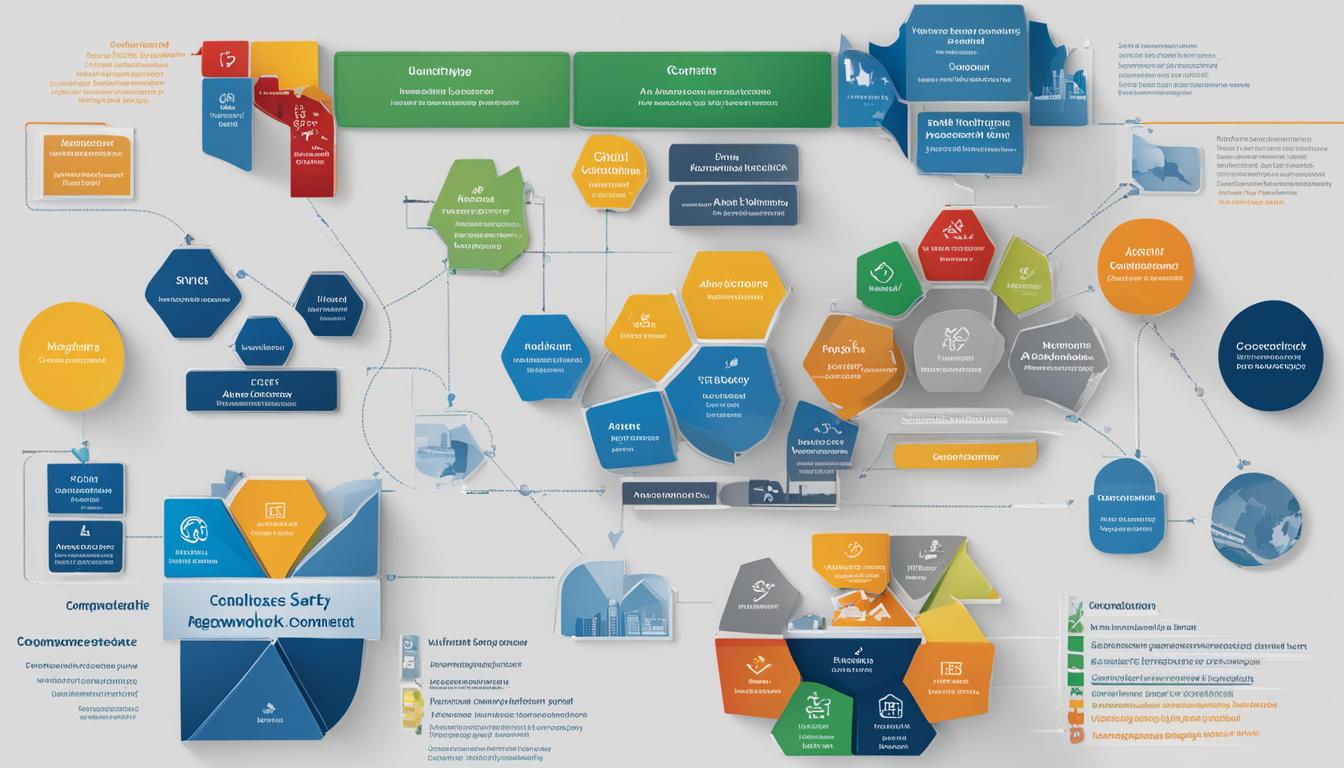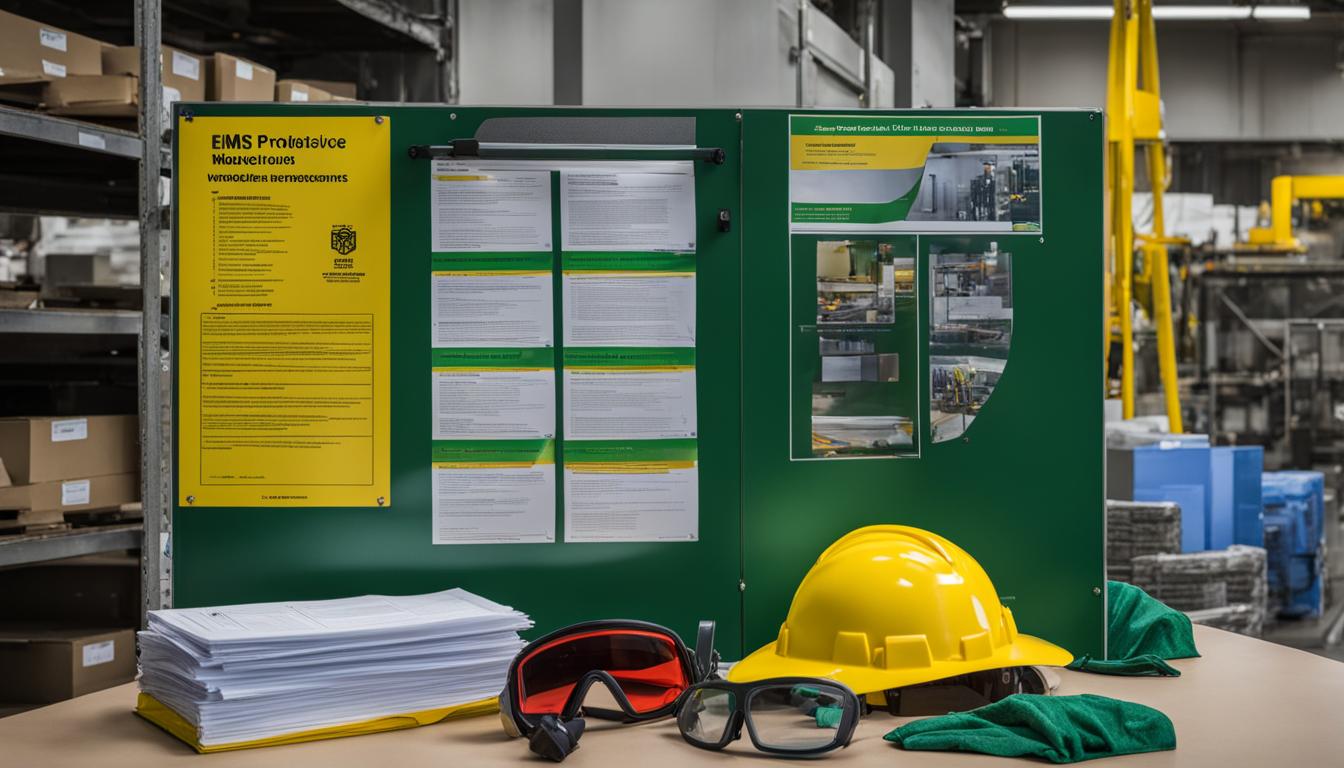Commercial Buildings
The importance of EHSMS and SWMS in Australian workplaces
EHSMS (Environmental Health and Safety Management System) and SWMS (Safe Work Method Statement) play a crucial role in maintaining a secure work environment in Australian workplaces. They are essential for ensuring the health and safety of employees, customers, and other stakeholders. These systems provide a structured approach to identifying hazards, evaluating and controlling risks, and complying with legal frameworks. EHSMS and SWMS are increasingly being adopted by organizations to achieve high standards in EHS management and integrate it with other aspects of their operations.
Key Takeaways:
- EHSMS and SWMS are vital for maintaining a secure work environment in Australian workplaces.
- These systems ensure the health and safety of employees, customers, and other stakeholders.
- EHSMS and SWMS provide a structured approach to identifying hazards and controlling risks.
- Adopting EHSMS and SWMS helps organizations achieve high standards in EHS management.
- EHSMS and SWMS integration with other operational aspects enhances overall safety and compliance.
Understanding EHSMS and its Components
EHSMS (Environmental Health and Safety Management System) is a comprehensive management system that encompasses various components to ensure effective environmental health and safety management in Australian workplaces. These components play a critical role in establishing and maintaining a proactive and systematic approach to EHS risk control.
EHSMS Components:
- Environmental Health and Safety Policy: A formal statement that outlines an organization’s commitment to preventing accidents, occupational exposures, and environmental events. It highlights the integration of EHS considerations into all operations and emphasizes compliance with laws and regulations.
- Management Commitment: Demonstrating commitment through a formal statement of intent, supporting performance goals, and providing resources for EHS obligations.
- Planning: Designing suitable processes and organizational structures, conducting risk assessments, and setting objectives to manage EHS aspects and associated risk control systems.
- Implementation: Translating planned controls and actions into practice, such as operational plans, contingency plans, performance measurement, and audits.
- Performance Measurement and Audits: Regularly reviewing the effectiveness of the EHS management system to identify gaps, prioritize actions, and allocate resources effectively.
- Management Review: Evaluating the overall performance of the EHSMS to adapt to changing circumstances and emerging issues.
By integrating these components, organizations can effectively identify hazards, evaluate and control risks, and improve their overall EHS performance. EHSMS provides a structured framework that enables organizations to achieve high standards in EHS management and integrate it with other aspects of their operations.
Table: Summary of EHSMS Components
| Component | Description |
|---|---|
| Environmental Health and Safety Policy | A formal statement of an organization’s commitment to preventing accidents, occupational exposures, and environmental events. |
| Management Commitment | Demonstrating commitment to EHS goals and providing resources to meet EHS obligations. |
| Planning | Designing processes and structures to manage EHS aspects and associated risk control systems. |
| Implementation | Translating planned controls and actions into practice. |
| Performance Measurement and Audits | Reviewing the effectiveness of the EHS management system through performance measures and audits. |
| Management Review | Evaluating the overall performance of the EHSMS to adapt to changing circumstances and emerging issues. |
Understanding the components of EHSMS is crucial for organizations to establish a comprehensive and effective environmental health and safety management system. Each component plays a vital role in ensuring that hazards and risks are identified, controlled, and managed in a proactive and systematic manner. By integrating these components into their operations, organizations can effectively protect the health and safety of their employees, customers, and other stakeholders, while also complying with legal obligations and improving their overall EHS performance.
The role of an environmental health and safety policy in EHSMS
An environmental health and safety policy is a crucial component of an Environmental Health and Safety Management System (EHSMS). It serves as a formal statement of our commitment to preventing or mitigating human and economic losses caused by accidents, occupational exposures, and environmental events. Our policy outlines the roles and expectations for our organization, employees, and stakeholders.
The environmental health and safety policy emphasizes the integration of EHS considerations into all phases of our operations. It highlights our commitment to compliance with laws and regulations and the continuous improvement of our EHS performance. By regularly reviewing and communicating our policy, we ensure its effectiveness and accessibility to all employees and relevant parties.

The Key Elements of Our Environmental Health and Safety Policy
- Commitment to a safe and healthy workplace: We are dedicated to providing a secure work environment and ensuring the well-being of our employees, contractors, visitors, and the community.
- Compliance with laws and regulations: We adhere to all applicable EHS laws, regulations, and industry standards to meet our legal obligations and promote responsible business practices.
- Integration of EHS into operations: We integrate EHS considerations into the design, planning, and execution of all our activities to minimize risks and prevent incidents.
- Continuous improvement: We strive for ongoing improvement in our EHS performance by setting objectives, monitoring progress, and implementing corrective actions.
Our environmental health and safety policy serves as a guiding framework for our EHSMS. It ensures a shared understanding of our commitment to safety, compliance, and continuous improvement. By embedding EHS considerations into our organizational culture, we create a safe and healthy work environment that benefits our employees, stakeholders, and the broader community.
The importance of management commitment in EHSMS
Management commitment is a crucial element in the successful implementation of an Environmental Health and Safety Management System (EHSMS). It sets the tone for the entire organization and establishes a culture of safety and compliance. Management commitment involves formal statements of intent, supporting performance goals, and the allocation of resources to meet EHS obligations.
When management demonstrates their commitment to EHSMS, it sends a clear message to employees and stakeholders that their health and safety are a top priority. By investing in EHSMS, organizations can create a safe and secure work environment, prevent accidents and injuries, and comply with legal requirements.
In addition, management commitment helps to establish accountability and responsibility for EHS performance. It ensures that adequate resources and processes are provided to identify, assess, and control risks effectively. By actively engaging in the EHSMS implementation process, management can foster employee involvement and participation, leading to a positive safety culture and improved overall EHS performance.
The role of management commitment:
- Establishing a safety-first culture
- Communicating the importance of EHS to all employees
- Allocating resources for EHSMS implementation
- Setting performance goals and expectations
- Ensuring compliance with legal requirements
- Providing leadership and support for EHS initiatives
By prioritizing and demonstrating management commitment, organizations can create a strong foundation for the successful implementation of their EHSMS. This commitment ensures that EHS becomes an integral part of the organization’s values and operations, ultimately leading to a safer and healthier workplace for all.
| Benefits of management commitment in EHSMS implementation |
|---|
| Enhanced safety culture |
| Reduced accidents and injuries |
| Improved overall EHS performance |
| Compliance with legal requirements |
| Increased employee engagement and participation |
Management commitment is a crucial factor in the successful implementation and maintenance of an effective EHSMS. By prioritizing EHS and providing the necessary resources and support, organizations can create a culture of safety and compliance, protecting the well-being of their employees and stakeholders. Management commitment not only ensures compliance with legal requirements but also fosters a proactive and positive safety culture, leading to improved overall EHS performance.
The Importance of Planning in EHSMS
Effective planning is a critical component of Environmental Health and Safety Management Systems (EHSMS) in Australian workplaces. Planning plays a crucial role in managing EHS aspects and associated risk control systems. It involves designing suitable processes and organizational structures, assessing risks, setting objectives, and implementing controls. Planning also includes identifying applicable EHS aspects, conducting risk assessments, and integrating additional controls or corrective actions when needed.
By incorporating comprehensive planning into EHSMS, organizations can proactively manage hazards and risks, ensuring the health and safety of employees and stakeholders. This systematic approach helps prevent accidents and injuries, promotes compliance with legal requirements, and enhances overall EHS performance. It is important to involve various sources of information, such as hazard/exposure assessments, inspections, permits, and employee feedback, while developing and disseminating new controls and corrective actions.
Implementing effective planning processes in EHSMS demonstrates a commitment to continuous improvement and proactive risk management. It enables organizations to adapt to changing circumstances, emerging issues, and new regulatory requirements, ensuring the ongoing success of their EHS programs.
The Benefits of Effective Planning in EHSMS
Planning is an essential aspect of EHSMS that offers numerous benefits for Australian workplaces. Some key benefits include:
- Improved Risk Management: Effective planning allows organizations to identify, assess, and control hazards and risks, reducing the likelihood of accidents, injuries, and environmental incidents.
- Enhanced Compliance: By incorporating legal requirements and industry standards into the planning process, organizations can ensure compliance with EHS regulations and avoid penalties or legal issues.
- Optimized Resource Allocation: Planning helps organizations allocate resources efficiently, ensuring that EHS initiatives receive adequate funding, personnel, and equipment.
- Increased Efficiency and Productivity: By proactively identifying potential issues and implementing controls, planning reduces downtime, delays, and disruptions, improving overall operational efficiency and productivity.
| Benefit | Description |
|---|---|
| Improved Risk Management | Effective planning allows organizations to identify, assess, and control hazards and risks, reducing the likelihood of accidents, injuries, and environmental incidents. |
| Enhanced Compliance | By incorporating legal requirements and industry standards into the planning process, organizations can ensure compliance with EHS regulations and avoid penalties or legal issues. |
| Optimized Resource Allocation | Planning helps organizations allocate resources efficiently, ensuring that EHS initiatives receive adequate funding, personnel, and equipment. |
| Increased Efficiency and Productivity | By proactively identifying potential issues and implementing controls, planning reduces downtime, delays, and disruptions, improving overall operational efficiency and productivity. |
Effective planning in EHSMS is a foundational element for creating a safe and healthy work environment. By integrating comprehensive planning processes, organizations can achieve greater control over EHS risks, ensure compliance, optimize resource allocation, and improve overall efficiency and productivity. Planning is an ongoing process that must be regularly reviewed and updated to address emerging challenges and meet evolving regulatory requirements. By prioritizing planning in EHSMS, organizations demonstrate a commitment to proactive risk management and the well-being of their employees and stakeholders.
The Implementation Process in EHSMS
The implementation process plays a critical role in the successful integration of Environmental Health and Safety Management Systems (EHSMS) within Australian workplaces. It involves translating the planned controls and actions into practice, ensuring that EHS policies and procedures are effectively implemented and followed by all employees. The implementation process covers various aspects, including overall plans and objectives, operational plans, contingency plans for emergencies, management of change, interaction with other parties, performance measurement and audits, corrective action implementation, document control, and contractor management.
During the implementation phase, it is crucial for organizations to align their business needs and risks with the requirements of the EHSMS. This ensures that all key areas are covered and appropriate control measures are implemented. Effective communication channels should be established between management, EHS personnel, and employees to facilitate the implementation process and address any potential issues or concerns. Regular monitoring and reporting are essential to track progress and identify areas for improvement. Additionally, organizations should provide adequate training and resources to support employees in understanding and implementing the EHSMS effectively.
| Key Components of the Implementation Process in EHSMS | Description |
|---|---|
| Overall Plans and Objectives | Establishing clear goals and objectives to guide the implementation of the EHSMS. This includes defining key performance indicators and targets. |
| Operational Plans | Developing detailed plans and procedures to guide day-to-day EHS activities and ensure compliance with legal requirements and industry standards. |
| Contingency Plans for Emergencies | Preparing and implementing plans to address emergency situations, including evacuation procedures, communication protocols, and emergency response teams. |
| Management of Change | Establishing processes to manage changes in the workplace that may impact EHS, such as new equipment, procedures, or organizational structures. |
| Interaction with Other Parties | Collaborating and coordinating with contractors, suppliers, regulators, and other relevant parties to ensure EHS requirements are met throughout the supply chain. |
| Performance Measurement and Audits | Implementing systems to measure and monitor EHS performance, conduct internal audits, and identify areas for improvement. |
| Corrective Action Implementation | Taking appropriate actions to address non-compliance, incidents, or identified deficiencies in the EHSMS. |
| Document Control | Establishing systems to manage and control documents related to the EHSMS, including policies, procedures, work instructions, and records. |
| Contractor Management | Implementing processes to select, evaluate, and monitor contractors based on their EHS performance and compliance with the EHSMS requirements. |
The successful implementation of EHSMS requires a collaborative effort from all levels of the organization. By effectively implementing the EHSMS, organizations can create a safe and healthy work environment, minimize risk, and demonstrate their commitment to protecting the well-being of employees and stakeholders.
The role of employees in EHSMS implementation
Employees play a crucial role in the successful implementation of EHSMS. As the front-line workers, they are responsible for ensuring that work is performed in a prudent and safe manner, following the established EHS management system. While regulations, policies, and plans provide guidance, it is the responsibility of individual employees to actively contribute to maintaining a safe laboratory environment or workplace.
Effective communication, training, and education programs are essential to ensure that employees understand their roles and responsibilities, adopt new protocols, and contribute to maintaining a safe work environment. By providing employees with the necessary knowledge and resources, organizations empower them to identify hazards, report incidents, and actively participate in risk control measures. By involving employees in the EHSMS implementation, organizations can tap into their expertise and insights, fostering a sense of ownership and commitment to workplace safety.
| Key roles of employees in EHSMS implementation |
|---|
| Adhering to established EHS policies and procedures |
| Participating in hazard identification and risk assessment |
| Reporting incidents, near misses, and potential hazards |
| Following safe work practices and using personal protective equipment (PPE) |
| Participating in training and competency programs |
| Engaging in regular communication and feedback mechanisms |
Empowering employees with the knowledge and resources to actively participate in EHSMS implementation not only enhances workplace safety but also cultivates a culture of shared responsibility and continuous improvement. When employees feel valued and involved in the EHS management system, they are more likely to be proactive in identifying and addressing potential risks, contributing to a safer and healthier work environment for all.
Organizations should ensure that EHSMS training programs cover the specific roles and responsibilities of employees in different work areas. By tailoring the training content to address unique hazards and risks in specific job functions, organizations can better equip employees with the necessary knowledge to work safely. Regular communication channels, such as safety meetings, toolbox talks, and newsletters, should be established to keep employees informed about any updates or changes in EHSMS policies and procedures.
By prioritizing employee involvement and engagement, organizations can harness the collective commitment and expertise of their workforce, creating a strong safety culture that permeates every aspect of their operations. It is through the active participation of employees that the true effectiveness of EHSMS implementation can be realized, leading to improved safety outcomes and a more secure work environment.

| Elements | Description |
|---|---|
| Evaluation | Regular reviews, performance measurements, and audits to assess the effectiveness of the EHSMS. |
| Identification of Gaps | Identifying deficiencies, areas for improvement, and emerging risks. |
| Resource Allocation | Allocating resources to address identified gaps and improve control measures. |
| Corrective Actions | Taking necessary actions to rectify deficiencies and enhance the effectiveness of the EHSMS. |
| Best Practices | Adopting industry best practices and staying informed about emerging trends. |
| Continuous Improvement | Striving for ongoing improvement in EHS performance and management practices. |
Understanding SWMS and Its Role in Workplace Safety
The Safe Work Method Statement (SWMS) is a crucial document that plays a vital role in ensuring workplace safety. It outlines the work processes, hazards, and control measures required to complete specific tasks or projects safely. By identifying hazards, assessing risks, and implementing appropriate control measures, SWMS helps organizations create a proactive approach to planning and managing workplace hazards, ensuring the health and safety of workers.
SWMS involves a comprehensive assessment of each step in a task or project, considering potential risks and identifying suitable control measures to mitigate them. It is a collaborative effort, involving consultation with employees, contractors, and other stakeholders to ensure that all perspectives are considered in developing the SWMS. Regular review, communication, and monitoring of SWMS are essential to ensure its effectiveness and compliance with legal requirements.
Using SWMS in Australian workplaces not only helps organizations meet their legal obligations but also creates a safer work environment. By following the documented control measures and guidelines, workers are better equipped to perform tasks safely, reducing the risk of accidents, injuries, and illnesses. SWMS also promotes a culture of safety by empowering employees to actively participate in identifying hazards and implementing controls, fostering a sense of ownership and responsibility for workplace safety.

Benefits of SWMS in Workplace Safety
Implementing SWMS in Australian workplaces brings several benefits for both employers and employees. Here are some key advantages:
- Improved Risk Management: SWMS helps organizations identify and assess workplace hazards, allowing them to implement appropriate control measures to reduce risks.
- Enhanced Safety Culture: By involving employees in the development and implementation of SWMS, organizations promote a culture of safety and encourage proactive hazard identification and control.
- Legal Compliance: SWMS ensures compliance with legal requirements, such as the Work Health and Safety (WHS) Act, demonstrating a commitment to workplace safety.
- Reduced Accidents and Injuries: By following the control measures outlined in SWMS, workers are better equipped to perform tasks safely, reducing the risk of accidents and injuries.
- Increased Productivity: A safe work environment leads to increased productivity as workers can focus on their tasks without worrying about potential hazards.
In conclusion, understanding SWMS and implementing it in Australian workplaces is essential for ensuring workplace safety. By identifying hazards, assessing risks, and implementing appropriate control measures, SWMS helps organizations create a proactive approach to managing workplace hazards. It promotes a culture of safety, reduces accidents and injuries, and ensures compliance with legal requirements. Employers and employees alike benefit from the improved risk management, enhanced safety culture, and increased productivity that SWMS brings.
The benefits of using EHSMS and SWMS in Australian workplaces
Implementing Environmental Health and Safety Management Systems (EHSMS) and Safe Work Method Statements (SWMS) in Australian workplaces offers numerous benefits. These systems are crucial for ensuring compliance with legal requirements, protecting the health and safety of employees and stakeholders, and preventing accidents and injuries. By adopting EHSMS and SWMS, organizations create a safer work environment and demonstrate their commitment to employee well-being.
EHSMS and SWMS improve risk management by providing a structured approach to identifying hazards, assessing risks, and implementing control measures. These systems allow organizations to proactively address potential risks and ensure that appropriate measures are in place to prevent accidents. By effectively managing hazards, organizations can reduce the occurrence of workplace incidents and create a safer environment for everyone.
Furthermore, implementing EHSMS and SWMS enhances productivity by promoting efficient work processes and minimizing disruptions caused by accidents or injuries. By having clear protocols and control measures in place, organizations reduce downtime and ensure that work can be carried out safely and efficiently. This not only improves productivity but also contributes to cost savings by preventing lost time and resources due to workplace incidents.
| Benefits of using EHSMS and SWMS in Australian workplaces |
|---|
| Compliance with legal requirements |
| Protection of health and safety |
| Prevention of accidents and injuries |
| Improved risk management |
| Enhanced productivity |
| Promotion of a positive safety culture |
| Commitment to employee well-being |
In addition, implementing EHSMS and SWMS promotes a positive safety culture within organizations. By prioritizing the health and safety of employees, organizations foster a work environment that values and emphasizes the importance of safety. This not only helps reduce workplace accidents but also boosts employee morale and satisfaction. Employees feel more confident and motivated when working in an environment that prioritizes their well-being.
Overall, the use of EHSMS and SWMS in Australian workplaces brings significant benefits to organizations. These systems ensure compliance with legal requirements, protect the health and safety of employees, prevent accidents and injuries, enhance risk management, improve productivity, promote a positive safety culture, and demonstrate a commitment to employees’ well-being. By implementing EHSMS and SWMS, organizations create a safer and more productive work environment, contributing to their overall success.

Best Practices for Implementing EHSMS and SWMS in Australian Workplaces
Implementing an Environmental Health and Safety Management System (EHSMS) and Safe Work Method Statement (SWMS) in Australian workplaces requires following best practices to ensure their effectiveness. These practices ensure that we create a safe work environment, comply with legal requirements, and effectively manage hazards and risks. By adhering to these best practices, we can protect the health and safety of our employees and stakeholders, prevent accidents and injuries, and promote a positive safety culture.
Engage Employees and Stakeholders
One of the key best practices is to actively engage employees and stakeholders in the implementation of EHSMS and SWMS. By involving them in the development and improvement of safety protocols, we can gain valuable insights, enhance ownership, and foster a sense of responsibility among all parties. Regular communication, training programs, and consultation sessions help ensure that everyone understands their roles and responsibilities, and actively contributes to maintaining a safe work environment.
Conduct Regular Training and Communication Programs
Regular training and communication programs are essential to ensure that all employees are aware of EHSMS and SWMS requirements and follow the established protocols. Training should cover topics such as hazard identification, risk assessment, incident reporting, emergency response, and the proper use of personal protective equipment. Additionally, effective communication channels should be established to disseminate important safety information, provide updates on EHSMS and SWMS, and encourage the reporting of potential hazards or incidents.
Regularly Review and Update Policies and Procedures
Regular reviews of policies and procedures are crucial to ensure that they align with changing regulatory requirements, industry standards, and emerging best practices. By conducting periodic reviews, we can identify areas for improvement, address any gaps or deficiencies, and update our protocols accordingly. It is important to involve relevant stakeholders, such as EHS personnel and employees, in the review process to gain their input and ensure that policies and procedures are practical, effective, and reflective of our organizational needs.
| Best Practices for Implementing EHSMS and SWMS in Australian Workplaces |
|---|
| Engage Employees and Stakeholders |
| Conduct Regular Training and Communication Programs |
| Regularly Review and Update Policies and Procedures |

“Implementing EHSMS and SWMS in Australian workplaces requires a proactive approach towards employee engagement, regular training programs, and periodic reviews of policies and procedures. By following these best practices, we can create a safe work environment, comply with legal requirements, and effectively manage hazards and risks.”
EHSMS and SWMS in specialized industries and sectors
EHSMS (Environmental Health and Safety Management System) and SWMS (Safe Work Method Statement) are not limited to specific industries or sectors. These comprehensive systems are applicable and beneficial across a wide range of specialized industries and sectors, ensuring the health, safety, and well-being of workers. Let’s explore some of the industries where EHSMS and SWMS play a crucial role:
Construction
In the construction industry, EHSMS and SWMS are essential for managing the unique hazards and risks associated with construction sites. These systems help organizations identify and control risks such as falls from height, hazardous materials, and construction machinery accidents. By implementing EHSMS and SWMS, construction companies can promote a safe working environment, prevent accidents, and comply with regulatory requirements.
Manufacturing
In the manufacturing sector, EHSMS and SWMS are vital for managing hazards related to the production process, machinery operation, and handling of materials. These systems help organizations implement control measures to prevent injuries, ensure safe work practices, and reduce the risk of accidents. By incorporating EHSMS and SWMS into their operations, manufacturers can create a culture of safety and protect their employees from workplace hazards.
Healthcare
In the healthcare industry, EHSMS and SWMS are crucial for maintaining a safe environment for patients, healthcare professionals, and support staff. These systems address risks associated with patient care, infection control, hazardous substances, and ergonomic hazards. By implementing EHSMS and SWMS, healthcare facilities can ensure compliance with regulations, minimize the risk of healthcare-associated infections, and promote a culture of safety.
Oil and Gas
The oil and gas industry presents unique challenges in terms of workplace safety and environmental management. EHSMS and SWMS are essential for managing risks associated with drilling operations, transportation, and handling of hazardous substances. These systems help organizations develop effective emergency response plans, implement safety protocols, and ensure compliance with stringent regulations. By incorporating EHSMS and SWMS, oil and gas companies can prevent accidents, protect the environment, and safeguard the well-being of their workforce.
Mining
In the mining industry, EHSMS and SWMS are critical for addressing the hazards and risks inherent in mining operations. These systems help organizations manage risks related to excavation, heavy machinery operation, and exposure to hazardous substances. By implementing EHSMS and SWMS, mining companies can create a safety-focused culture, reduce the likelihood of accidents and occupational illnesses, and maintain compliance with regulatory requirements.
Transportation
EHSMS and SWMS are also applicable in the transportation sector, where they assist in managing risks associated with different modes of transportation, such as road, air, rail, and maritime. These systems help transportation companies identify and control hazards related to vehicle operation, loading and unloading of cargo, and handling of dangerous goods. By implementing EHSMS and SWMS, transportation companies can enhance driver and passenger safety, prevent accidents, and comply with transportation safety regulations.

Another significant benefit of technology in EHSMS and SWMS is the ability to remotely monitor and control workplace activities. IoT devices can track environmental conditions, machinery performance, and employee behavior in real-time. This enables organizations to identify potential hazards and risks promptly, take corrective actions, and prevent incidents before they occur. Remote monitoring also allows for quick response and intervention in emergency situations, improving overall safety and reducing the likelihood of catastrophic events.
| EHSMS | SWMS | |
|---|---|---|
| Enhanced data management | Technology enables efficient data collection, analysis, and reporting, leading to better decision-making and improved EHS performance. | SWMS can be digitized, making it easier to create, update, and communicate to workers, ensuring they have access to the latest safety information. |
| Increased efficiency | Automation of routine tasks and processes saves time and resources, allowing EHS professionals to focus on strategic initiatives. | SWMS templates and software streamline the development and approval process, reducing administrative burden and ensuring compliance. |
| Improved communication and collaboration | Technology facilitates real-time communication and collaboration between different stakeholders, ensuring everyone is aligned and informed. | SWMS can be easily shared electronically, allowing for quick and efficient dissemination of safety requirements. |
| Advanced analytics and predictive capabilities | Technology enables the analysis of large datasets, uncovering patterns, trends, and insights for proactive risk management. | Advanced analytics can be used to identify high-risk tasks and allocate resources accordingly, preventing incidents and injuries. |
With the continuous advancement of technology, we can expect further enhancements in EHSMS and SWMS. Artificial intelligence and machine learning algorithms have the potential to automate risk assessments, predict potential hazards, and suggest appropriate control measures. The integration of wearables, sensors, and drones can provide real-time monitoring of individual workers and hazardous areas. These technological advancements will undoubtedly contribute to creating even safer and healthier work environments.
The Future of EHSMS and SWMS in Australian Workplaces
As we look ahead to the future of workplace safety in Australia, it is clear that the adoption of Environmental Health and Safety Management Systems (EHSMS) and Safe Work Method Statements (SWMS) will continue to play a crucial role. With advancements in technology, evolving regulatory requirements, and changing industry dynamics, EHSMS and SWMS will adapt to meet the emerging challenges faced by Australian workplaces.
One key trend in the future of EHSMS and SWMS is the integration of technology. Digital platforms, artificial intelligence, data analytics, and automation will enhance the effectiveness of these systems. Organizations will be able to streamline data collection, perform real-time risk assessments, and improve communication and reporting processes. Mobile apps and cloud-based systems will provide accessibility and facilitate remote monitoring and control of workplace activities.
“The integration of technology in EHSMS and SWMS will revolutionize workplace safety in Australian organizations. It will enable us to proactively identify hazards, assess risks, and implement control measures in a more efficient and accurate manner.”
Another important aspect of the future of EHSMS and SWMS is a focus on proactive risk management. Organizations will place a greater emphasis on identifying and addressing potential hazards before they result in accidents or injuries. By implementing comprehensive risk assessment strategies and predictive analytics, workplaces will be better equipped to prevent incidents and create safer environments for employees.
Furthermore, the future of EHSMS and SWMS will see a continued commitment to employee engagement. Organizations will recognize the importance of involving employees in the development and implementation of safety protocols. Effective communication, training, and education programs will ensure that employees understand their roles and responsibilities, fostering a culture of safety throughout the organization.
The Future of EHSMS and SWMS in Australian Workplaces: Summary
- The future of EHSMS and SWMS in Australian workplaces will embrace advancements in technology, evolving regulatory requirements, and changing industry dynamics.
- Technology will play a significant role in enhancing the effectiveness of EHSMS and SWMS, enabling streamlined data collection, real-time risk assessments, and improved communication.
- Proactive risk management will be a key area of focus, with organizations prioritizing the identification and mitigation of potential hazards before incidents occur.
- Employee engagement will continue to be emphasized, with communication, training, and education programs ensuring that employees are active participants in workplace safety.
By embracing these trends and continuously improving EHSMS and SWMS, Australian workplaces can create safer environments, protect the well-being of their employees, and contribute to the overall success of their organizations.
Conclusion
In conclusion, implementing an Environmental Health and Safety Management System (EHSMS) and Safe Work Method Statement (SWMS) is crucial for maintaining a safe and secure work environment in Australian workplaces. These systems provide a structured approach to identifying and controlling risks, ensuring compliance with legal requirements, and improving overall EHS performance.
By adhering to best practices and engaging employees and stakeholders, organizations can create a positive safety culture and prevent accidents or injuries. Ongoing evaluation and improvement are essential to adapt to changing circumstances and continuously enhance EHS performance.
As technology continues to advance, EHSMS and SWMS will leverage digital platforms, data analytics, and automation to optimize risk management processes. There will be a greater emphasis on proactive risk assessment, employee engagement, and sustainable practices to create safer and healthier workplaces.
In summary, EHSMS and SWMS play a vital role in ensuring the health, safety, and well-being of employees and stakeholders in Australian workplaces. By integrating these systems and staying updated on evolving regulations and industry dynamics, organizations can meet legal requirements, mitigate risks, and contribute to a secure work environment for all.
FAQ
What is EHSMS?
EHSMS stands for Environmental Health and Safety Management System. It is a comprehensive system that ensures effective environmental health and safety management in workplaces.
What are the components of EHSMS?
The components of EHSMS include an environmental health and safety policy, management commitment, planning, implementation, performance measurement and audits, and management review.
What is the role of an environmental health and safety policy in EHSMS?
An environmental health and safety policy is a formal statement of an organization’s commitment to preventing accidents, occupational exposures, and environmental events. It outlines roles, expectations, compliance with laws, and continuous improvement.
Why is management commitment important in EHSMS?
Management commitment is critical for successful EHS program implementation and creating a strong safety culture. It sets the tone, provides resources, and ensures compliance, energy efficiency, and continuous improvement.
What is the importance of planning in EHSMS?
Planning is essential in EHSMS as it involves designing processes, assessing risks, setting objectives, and implementing controls. It helps manage EHS aspects, identify hazards, and integrate new controls or corrective actions.
What is the implementation process in EHSMS?
The implementation process in EHSMS involves translating planned controls into practice. It includes overall plans, contingency plans, performance measurement, audits, corrective actions, document control, and contractor management.
What is the role of employees in EHSMS implementation?
Employees play a crucial role in implementing EHSMS by following established protocols, ensuring safe work practices, and actively contributing to a safe work environment through effective communication and training programs.
Why is ongoing evaluation and improvement important in EHSMS?
Ongoing evaluation and improvement help identify gaps, prioritize actions, allocate resources, and adapt to changing circumstances and regulatory requirements. It demonstrates a commitment to maintaining and enhancing EHS performance.
What is SWMS?
SWMS stands for Safe Work Method Statement. It is a document that outlines work processes, hazards, and control measures required for specific tasks or projects to be completed safely.
What are the benefits of using EHSMS and SWMS in Australian workplaces?
Using EHSMS and SWMS helps ensure compliance, protect health and safety, prevent accidents, reduce environmental impact, improve risk management, enhance productivity, promote a positive safety culture, and contribute to overall business success.
What is the legal framework for EHSMS and SWMS in Australia?
The Work Health and Safety Act 2011 sets out the primary duties and obligations for employers, employees, and other duty holders. EHSMS and SWMS assist organizations in meeting their legal obligations and demonstrating compliance with the relevant legislation.
What are the best practices for implementing EHSMS and SWMS in Australian workplaces?
Best practices include securing management commitment, engaging employees and stakeholders, conducting regular training and communication programs, conducting thorough risk assessments, and regularly reviewing and updating policies and procedures.
In which industries and sectors are EHSMS and SWMS applicable?
EHSMS and SWMS are applicable to a wide range of industries and sectors, including construction, manufacturing, healthcare, laboratories, oil and gas, mining, transportation, and more.
How does technology enhance EHSMS and SWMS?
Technology enhances EHSMS and SWMS by streamlining data collection, analysis, reporting, and communication processes. It provides real-time access to information, simplifies documentation and training, and facilitates remote monitoring and control of workplace activities.
What does the future hold for EHSMS and SWMS in Australian workplaces?
The future of EHSMS and SWMS will embrace advancements in technology, evolving regulatory requirements, and changing industry dynamics. Digital platforms, AI, data analytics, and automation will optimize EHS management processes and enhance workplace safety.

